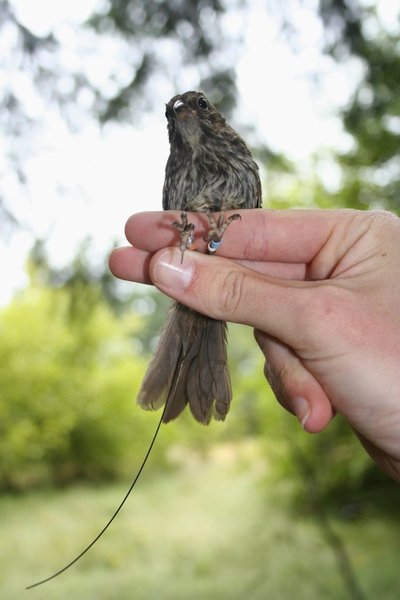October 21, 2009
It takes two to tutor a sparrow
It may take a village to raise a child, and apparently it takes at least two adult birds to teach a young song sparrow how and what to sing.
In the first study conducted in the field to examine how juvenile song birds learn their repertoire, University of Washington researchers have learned that eavesdropping on the singing conversations between two adult sparrows appears to be a key event in song learning. The results are being published Oct. 21 in the online edition of the Proceedings of the Royal Society B. The Royal Society is the British version of the National Academy of Sciences.
Scientists study how song birds acquire their songs because the process has parallels with human language learning. In each case eavesdropping seems to play a role.
The researchers used radio telemetry to track the young song sparrows (Melospiza melodia) and monitor responses to recorded bird songs played over two speakers. Only male birds were studied because female sparrows generally do not sing.
“We measured how close the juveniles came to the speakers, how long it took for them to approach and their overall movements. They generally moved closer, faster and farther when they heard recordings of two adult male sparrows interacting than when they heard recordings of a solo sparrow singing,” said Christopher Templeton, a UW biology doctoral student and lead author of the study.
The research stems from an earlier UW laboratory study that showed young sparrows acquire more of their songs when they eavesdrop on two birds than when they interact with a tutor. That research was headed by Michael Beecher, a UW psychology and biology professor, who is a co-author of the new paper.
For the field study, the researchers radio tagged 11 male sparrows in Seattle’s undeveloped Discovery Park. These birds were about two months old and had not yet begun to sing. The park has a year-round resident population of approximately l50 breeding pairs.
To test a young bird’s reactions, it was first located by its radio signal and then the speakers were placed about 50 yards from the animal’s location. Finally the bird was exposed to five minutes of pre-recorded song, either from pairs of song sparrows, a sparrow and a chickadee (effectively a solo sparrow) or a pair of chickadees (the control condition). All of the sparrow recordings were from birds that were no longer alive, so that the songs the young birds heard were not familiar. Chickadees commonly live in the same habitat as song sparrows, so sparrows are familiar with their songs.
That the juvenile birds approached the simulated interaction of two song sparrows but largely ignored the solo singing of a song sparrow lends support to the social eavesdropping hypothesis proposed by Beecher. This theory says young birds learn to sing by eavesdropping on singing between adult birds, rather than listening to a single bird or directly interacting with an adult.
“They seem to be learning how to sing and interact by eavesdropping on interactions. This way they can learn shared songs, which will be important for their future success. Having shared song is the basis of song sparrow communications,” said Templeton.
“By listening to two birds, the juvenile can also learn how the songs are used, something he can’t learn by listening to a single bird. The young bird could do this by directly interacting with a mature adult bird, but that is risky because he might be chased away or beaten up.”
Co-authors of the study are Caglar Akcay, a UW psychology doctoral student, and Elizabeth Campbell, a research technician. Funding for the work came from the National Science Foundation, the American Museum of Natural History, American Ornithologists’ Union, the Animal Behavior Society and the UW Royalty Research Fund.
###
For more information, contact Templeton at ctemple2@u.washington.edu or 206-523-1277 or Beecher at 206-543-6545 or beecher@u.washington.edu.

